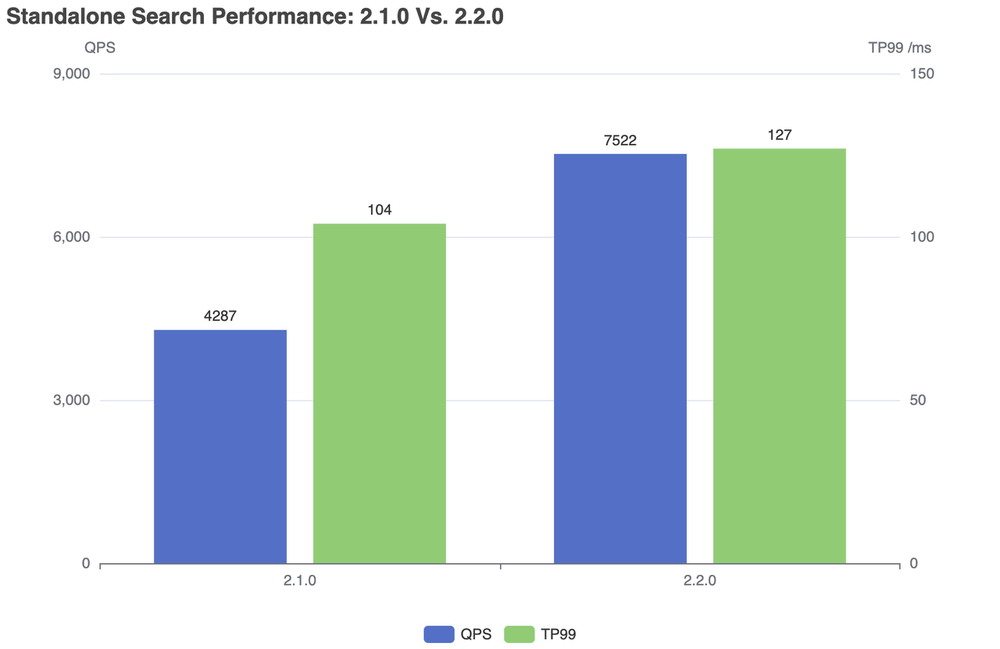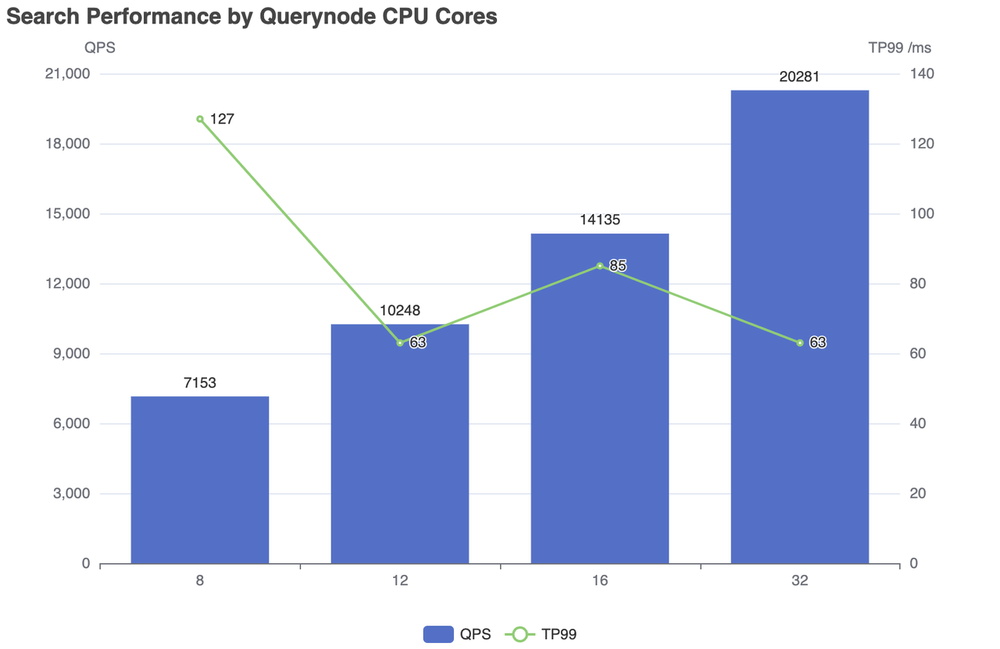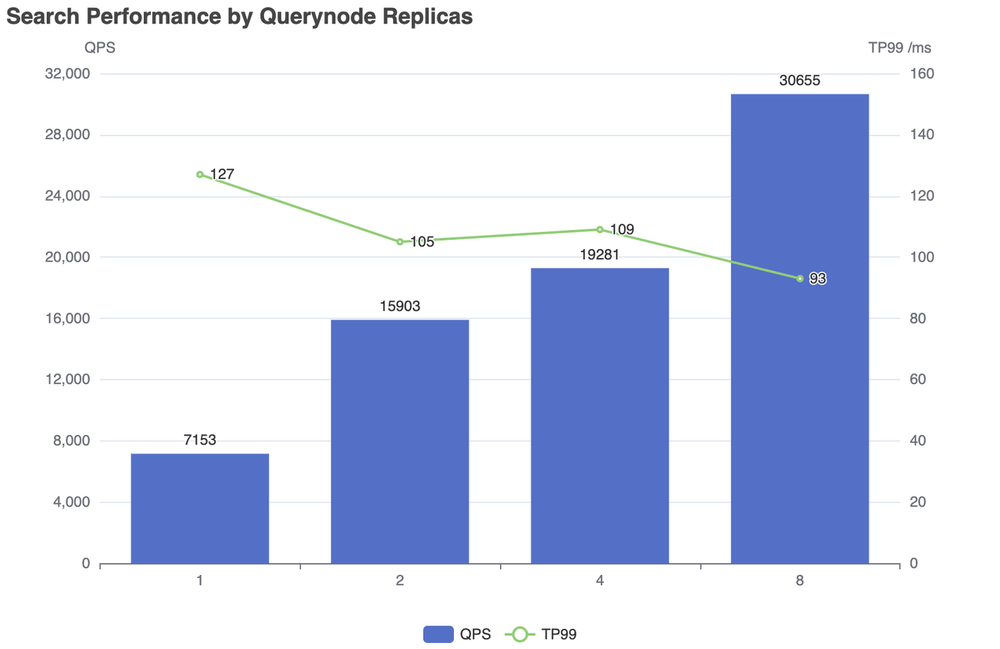Milvus 2.2 Benchmark Test Report
This report shows the major test results of Milvus 2.2.0. It aims to provide a picture of Milvus 2.2.0 search performance, especially in the capability to scale up and scale out.

We have recently run a benchmark against Milvus 2.2.3 and have the following key findings:
- A 2.5x reduction in search latency
- A 4.5x increase in QPS
- Billion-scale similarity search with little performance degradation
- Linear scalability when using multiple replicas
For details, welcome referring to this whitepaper and related benchmark test code.
Summary
- Comparing with Milvus 2.1, the QPS of Milvus 2.2.0 increases over 48% in cluster mode and over 75% in standalone mode.
- Milvus 2.2.0 has an impressive capability to scale up and scale out:
- QPS increases linearly when expanding CPU cores from 8 to 32.
- QPS increases linearly when expanding Querynode replicas from 1 to 8.
Terminology
Click to see the details of the terms used in the test
| Term | Description |
|---|---|
| nq | Number of vectors to be searched in one search request |
| topk | Number of the nearest vectors to be retrieved for each vector (in nq) in a search request |
| ef | A search parameter specific to HNSW index |
| RT | Response time from sending the request to receiving the response |
| QPS | Number of search requests that are successfully processed per second |
Test environment
All tests are performed under the following environments.
Hardware environment
| Hardware | Specification |
|---|---|
| CPU | Intel(R) Xeon(R) Gold 6226R CPU @ 2.90GHz |
| Memory | 16*\32 GB RDIMM, 3200 MT/s |
| SSD | SATA 6 Gbps |
Software environment
| Software | Version |
|---|---|
| Milvus | v2.2.0 |
| Milvus GO SDK | v2.2.0 |
Deployment scheme
- Milvus instances (standalone or cluster) are deployed via Helm on a Kubernetes cluster based on physical or virtual machines.
- Different tests merely vary in the number of CPU cores, the size of memory, and the number of replicas (worker nodes), which only applies to Milvus clusters.
- Unspecified configurations are identical to default configurations.
- Milvus dependencies (MinIO, Pulsar and Etcd) store data on the local SSD in each node.
- Search requests are sent to the Milvus instances via Milvus GO SDK.
Data sets
The test uses the open-source dataset SIFT (128 dimensions) from ANN-Benchmarks.
Test pipeline
- Start a Milvus instance by Helm with respective server configurations as listed in each test.
- Connect to the Milvus instance via Milvus GO SDK and get the corresponding test results.
- Create a collection.
- Insert 1 million SIFT vectors. Build an HNSW index and configure the index parameters by setting
Mto8andefConstructionto200. - Load the collection.
- Search with different concurrent numbers with search parameters
nq=1, topk=1, ef=64, the duration of each concurrency is at least 1 hour.
Test results
Milvus 2.2.0 v.s. Milvus 2.1.0
Cluster
Server configurations (cluster)
queryNode:
replicas: 1
resources:
limits:
cpu: "12.0"
memory: 8Gi
requests:
cpu: "12.0"
memory: 8Gi
Search performance
| Milvus | QPS | RT(TP99) / ms | RT(TP50) / ms | fail/s |
|---|---|---|---|---|
| 2.1.0 | 6904 | 59 | 28 | 0 |
| 2.2.0 | 10248 | 63 | 24 | 0 |

Standalone
Server configurations (standalone)
standalone:
replicas: 1
resources:
limits:
cpu: "12.0"
memory: 16Gi
requests:
cpu: "12.0"
memory: 16Gi
Search performance
| Milvus | QPS | RT(TP99) / ms | RT(TP50) / ms | fail/s |
|---|---|---|---|---|
| 2.1.0 | 4287 | 104 | 76 | 0 |
| 2.2.0 | 7522 | 127 | 79 | 0 |

Milvus 2.2.0 Scale-up
Expand the CPU cores in one Querynode to check the capability to scale up.
Server configurations (cluster)
queryNode:
replicas: 1
resources:
limits:
cpu: "8.0" /"12.0" /"16.0" /"32.0"
memory: 8Gi
requests:
cpu: "8.0" /"12.0" /"16.0" /"32.0"
memory: 8Gi
Search Performance
| CPU cores | Concurrent Number | QPS | RT(TP99) / ms | RT(TP50) / ms | fail/s |
|---|---|---|---|---|---|
| 8 | 500 | 7153 | 127 | 83 | 0 |
| 12 | 300 | 10248 | 63 | 24 | 0 |
| 16 | 600 | 14135 | 85 | 42 | 0 |
| 32 | 600 | 20281 | 63 | 28 | 0 |

Milvus 2.2.0 Scale-out
Expand more replicas with more Querynodes to check the capability to scale out.
Note: the number of Querynodes equals the replica_number when loading the collection.
Server configurations (cluster)
queryNode:
replicas: 1 / 2 / 4 / 8
resources:
limits:
cpu: "8.0"
memory: 8Gi
requests:
cpu: "8.0"
memory: 8Gi
| Replicas | Concurrent Number | QPS | RT(TP99) / ms | RT(TP50) / ms | fail/s |
|---|---|---|---|---|---|
| 1 | 500 | 7153 | 127 | 83 | 0 |
| 2 | 500 | 15903 | 105 | 27 | 0 |
| 4 | 800 | 19281 | 109 | 40 | 0 |
| 8 | 1200 | 30655 | 93 | 38 | 0 |

What's next
- Try performing Milvus 2.2.0 benchmark tests on your own by referring to this guide, except that you should instead use Milvus 2.2 and Pymilvus 2.2 in this guide.